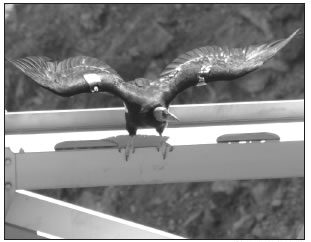|
Related story Still flying high: Grand Canyon tourists are thrilling to the sight of the rare California condor |
Consuming wild game shot with conventional bullets poses a larger risk for lead poisoning in humans than previously thought, according to a study released by the nonprofit Peregrine Fund and Washington State University last month.
Radiological tests of animals shot with lead bullets showed lead fragments dispersed significantly within the meat, and at surprisingly high concentrations.
“This is one more piece of evidence that points to lead bullets as a source of contamination in our environment,” said Rick Watson, vice president of the Peregrine Fund.
“We have known for years that lead residues from bullets poison birds and other scavengers. Now it appears that this dangerous contaminant exists in food that people eat as well.”

A condor alights on Navajo Bridge at the Vermillion Cliffs near Lee’s Ferry on the Colorado River. Photo by Wendy Mimiaga.
The study, called “Ingestion of Spent Lead Ammunition: Implications for Wildlife and Humans,” was originally conducted to determine lead-poisoning levels for the California condor, an endangered species that regularly eats carcasses left over from hunting season.
Researchers found the condors were dying from exposure to lead fragments in rifle-shot deer on Arizona’s Kaibab Plateau.
In 2007 nearly 3,000 hunters on the Kaibab Plateau successfully reversed the condor death trend by switching to non-lead copper bullets, under a voluntary program conducted by the Peregrine Fund and the Arizona Department of Game and Fish.
But X-rays of game shot with lead bullets so alarmed researchers, they took the study a step further.
“We followed a thread of evidence to the point we found lead-infected game is also a risk to human consumption and that is when people really pay attention,” said Chris Parish, a biologist with the Peregrine Fund who participated in the study.
“What it suggests is that we’ve been unknowingly eating small amounts of lead as well, and for me as a family person who prides myself on the wild game I bring home, this information is very valuable. The easy solution is these new non-lead bullets.”
The study analyzed 30 whitetail deer killed under normal hunting conditions in Wyoming with standard lead-core ammunition. X-rays showed widespread dispersal of lead fragments in the carcasses. Fragments ranged in size from smaller than a grain of table salt to as large as a sesame seed.
A good shot will pass through the animal, while the shock wave causes the fatal injuries. “But even animals that had a clean-pass through had scary amounts of lead fragments,” Parish said. “This is going to floor the hunters.”
Up to 700 particles of lead mushroomed into the animal from one bullet, according to the study. And toxic levels of lead are returned to the hunter in packaged meat.
Each of the 30 carcasses in the study was taken to a different commercial meat-processor for standard preparation of ground meat and boneless steaks. Processors removed the meat around the wound and along the bullet’s path, but lead fragments still ended up in packaged meat, both ground and in steaks.
The new study shows that eating game killed with lead bullets is a public health issue. But more work is needed, said Kathy Sullivan, a public-lands manager with the Arizona Department of Game and Fish.
“This information is just coming out and it is raising some eyebrows, so we need more research about how much lead hunters are consuming,” Sullivan said. “Studies are needed that test lead blood levels in hunters.”
In humans even small amounts of lead ingested or inhaled are toxic, especially for children, and can impair cognitive ability. Lead poisoning damages neural activity, kidney structure and bone and inhibits blood formation.
Several investigations of subsistencehunter families have shown elevated levels of lead.
Non-lead bullets are gaining acceptance. A Peregrine Fund questionnaire showed 93 percent of hunters who participated in a copper-bullet program found those comparable or superior to lead-based bullets. Researchers hope current hunters and future generations will choose non-lead ammo.
“The solution is simple,” Sullivan said. “Why would you feed [lead-shot venison] to your kids if you had a choice not to?”
The issue demonstrates how humans and the natural world are interconnected, Parish said.
“This is a fine example of what you learn from your environment when you study a single species,” Parish said. “The condor has taught us that we have overlooked this threat of lead poisoning all these years. I think this insight, and the implications for hunters and their families, is the greatest thing about the program.”

